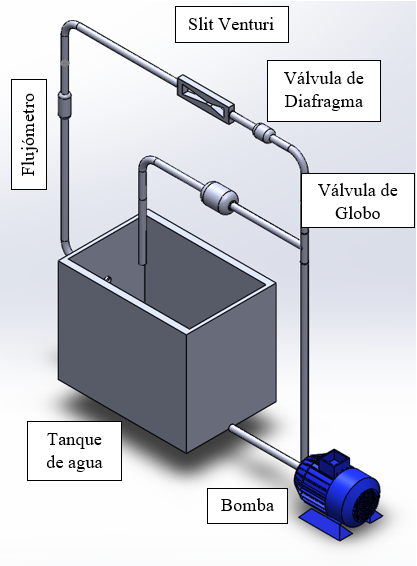Experimental measurement of cavitation cloud density in a Slit Venturi
DOI:
https://doi.org/10.37636/recit.v5n4e231Keywords:
Venturi, Cavitation, Thoma Number, Cavitation coefficient, Reynolds numberAbstract
In the present work, the experimental characterization of the formation and development of the cavitation cloud in different liquid temperatures 20, 30, 40, and 50 °C is reported. For this, a hydraulic installation was built whose main element is a Venturi tube with a rectangular section, with it, the necessary flow conditions were generated to form cavitation and measure the thermodynamic properties for the calculation of the Thoma and Reynolds adimensional numbers. The average bias error of the measurements did not exceed 1%, for this reason, the good quality of the calculation in the Thoma and Reynolds numbers was ensured. With the numbers of Thoma "σ" and Re, the different phases of the cavitation cloud were characterized, from incipient, quasi, developed, and supercavitation in the temperature range of the experiment, finding that the transition from incipient to developed cavitation is easier at room temperature since the flow rate will increase only 15.82% compared to the other temperatures. Finally, the density of the fluid in the temperature range of the test remained constant, since it did not vary more than 1%, so it did not affect the flow regime.
Downloads
References
Ki-Han Kim et Al., "Advanced Experimental and Numerical Techniques for Cavitation Erosion Prediction", Fluid Mechanics and Its Applications, Volume 106, Springer, 2014. https://doi.org/10.1007/978-94-017-8539-6 DOI: https://doi.org/10.1007/978-94-017-8539-6
R.W., Fox, A.T., McDonald "Introduction to Fluid Mechanics", 9th. Edition, Wiley and Sons, USA. 2015 Fox and McDonald's Introduction to Fluid Mechanics, 10th Edition | Wiley
F. M., White, "Fluid Mechanics" 7th. Edition, McGraw-Hill, USA. 2009. Fluid Mechanics (mheducation.com)
S., Hattori, B.H., Sun and F.G., Hammitt, "An application of bubble collapse pulse height spectra to venturi cavitation erosion of 1100-o aluminum", Wear, vol. 103, pp. 119 - 131, 1985. https://doi.org/10.1016/0043-1648(85)90128-0 DOI: https://doi.org/10.1016/0043-1648(85)90128-0
F. Payri, R. Payri, F.J. Salvador, J. Martínez-López, "A contribution to the understanding of cavitation effects in Diesel injector nozzles through a combined experimental and computational investigation", Computers & Fluids vol. 58, pp. 88-101, 2012. https://doi.org/10.1016/j.compfluid.2012.01.005 DOI: https://doi.org/10.1016/j.compfluid.2012.01.005
B., Charrière, J., Decaix, E., Goncalvès., "A comparative study of cavitation models in a Venturi flow", European Journal of Mechanics B/Fluids, vol 49, pp. 287 - 297, 2012. https://doi.org/10.1016/j.euromechflu.2014.10.003 DOI: https://doi.org/10.1016/j.euromechflu.2014.10.003
M. Wosnik, R.E.A. Arndt, "Measurements in high void-fraction bubbly wakes created by ventilated supercavitation", J. Fluids Eng., vol 135, 2013. https://doi.org/10.1115/1.4023193 DOI: https://doi.org/10.1115/1.4023193
S.L. Ceccio, "Friction drag reduction of external flows with bubble and gas injection", Ann. Rev. Fluid Mech. vol 42, pp. 183 - 203, 2010. https://doi.org/10.1146/annurev-fluid-121108-145504 DOI: https://doi.org/10.1146/annurev-fluid-121108-145504
J.P, Franc, J.M., Michel, "Fundamentals of Cavitation", Kluwer Academic Publishers, 2004. https://doi.org/10.1007/1-4020-2233-6 DOI: https://doi.org/10.1007/1-4020-2233-6
P. Tomov, S. Khelladi, F. Ravelet, C. Sarraf, F. Bakir, P. Vertenoeuil, "Experimental study of aerated cavitation in a horizontal venturi nozzle", Experimental Thermal and Fluid Science. Vol, 70, pp. 85 - 95, 2016. https://doi.org/10.1016/j.expthermflusci.2015.08.018 DOI: https://doi.org/10.1016/j.expthermflusci.2015.08.018
K., Sato, K., Hachino and Y., Saito, "Inception and Dynamics of Traveling- Bubble-Type Cavitation in a Venturi", Proceedings of Asme FEDSM2003-45322, 2003. https://doi.org/10.1115/FEDSM2003-45322 DOI: https://doi.org/10.1115/FEDSM2003-45322
H. Ghassemi, H. Farshi Fasih, "Application of small size cavitating venturi as flow controller and flow meter", Flow Measurement and Instrumentation, vol. 22, no. 5, pp. 406 - 412, 2011. https://doi.org/10.1016/j.flowmeasinst.2011.05.001 DOI: https://doi.org/10.1016/j.flowmeasinst.2011.05.001
T. A. Bashir, A. G. Soni, A. V. Mahulkar, A. B. Pandit, "The CFD Driven Optimisation of a Modified Venturi for Cavitational Activity", The Canadian Journal of Chemical Engineering, vol. 89, pp 1366 - 1375, 2011. https://doi.org/10.1002/cjce.20500 DOI: https://doi.org/10.1002/cjce.20500
X. Long, J. Zhang, J. Wang. M. Xu, Q. Lyu, B. Ji, "Experimental investigation of the global cavitation dynamic behaviour in a venturi tube with special emphasis on the cavity length variation", International Journal of Multiphase Flow, vol. 89, pp. 290 - 298, 2017. https://doi.org/10.1016/j.ijmultiphaseflow.2016.11.004 DOI: https://doi.org/10.1016/j.ijmultiphaseflow.2016.11.004

Published
How to Cite
Issue
Section
Categories
License
Copyright (c) 2022 Alejandro Díaz Martínez, Jesús Eduardo Rivera López, José Luis Arciniega Martínez, Carlos Alfonso Juárez Navarro, Guadalupe Juliana Gutiérrez Paredes, Gabriela Esmeralda Orozco Durán

This work is licensed under a Creative Commons Attribution 4.0 International License.
The authors who publish in this journal accept the following conditions:
The authors retain the copyright and assign to the journal the right of the first publication, with the work registered with the Creative Commons Attribution license 4.0, which allows third parties to use what is published as long as they mention the authorship of the work and the first publication in this magazine.
Authors may make other independent and additional contractual agreements for the non-exclusive distribution of the version of the article published in this journal (eg, include it in an institutional repository or publish it in a book) as long as they clearly indicate that the work it was first published in this magazine.
Authors are allowed and encouraged to share their work online (for example: in institutional repositories or personal web pages) before and during the manuscript submission process, as it can lead to productive exchanges, greater and more quick citation of published work (see The Effect of Open Access).











